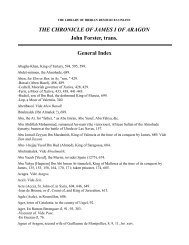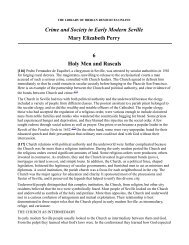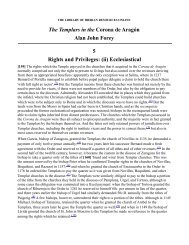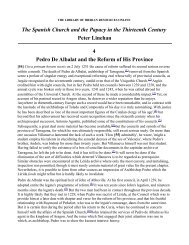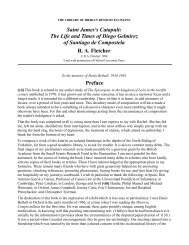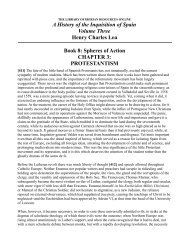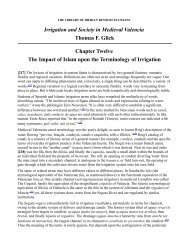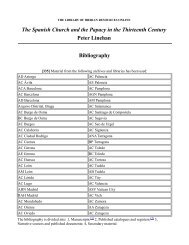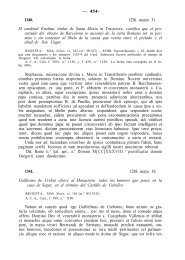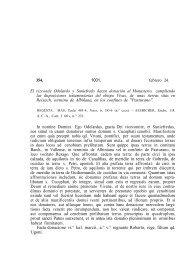Chapter 11 - The Library of Iberian Resources Online
Chapter 11 - The Library of Iberian Resources Online
Chapter 11 - The Library of Iberian Resources Online
You also want an ePaper? Increase the reach of your titles
YUMPU automatically turns print PDFs into web optimized ePapers that Google loves.
et de que quiero seertrobador,<br />
se ioper resposs' aver su amor,<br />
dono al demo los otros amores.<br />
Schindler's own rather free translation was given as:<br />
Rose among roses, O sweetest <strong>of</strong> flowers,<br />
Chosen <strong>of</strong> women, to thee bring we homage.<br />
[168]<br />
Rose among roses...<br />
Rose <strong>of</strong> beauty, fairest vision,<br />
Mystic flower <strong>of</strong> purest joy,<br />
Holy essence thou <strong>of</strong> purest joy,<br />
Victor over pain and woe!<br />
To her service I have pledged me<br />
For to be her troubadour.<br />
If her love I could but gain me,<br />
Earthly loves would go for naught . [21]<br />
Schindler also added the following brief description :<br />
<strong>The</strong> Tenth Canticle from the "Cantigas de Santa Maria" <strong>of</strong> the King Alfonso el Sabio. (Spain,<br />
XIII Century). This is a song in praise <strong>of</strong> Saint Mary, <strong>of</strong> her marvellous goodness and <strong>of</strong> her<br />
great power.<br />
From the illustrated collection, containing poem and melody, in the castle <strong>of</strong> the Escorial,<br />
Madrid, Spain.<br />
Villalba arranged the cantiga for solo, chorus, and piano accompaniment. <strong>The</strong> opening refrain, which<br />
he designated as tiples, was to be sung by the sopranos and repeated by the chorus. <strong>The</strong> sopranos<br />
followed, singing the individual strophes to a harmonized piano accompaniment. Schindler, on the<br />
other hand, preferred an a cappella setting, having the contralto sing the opening refrain, which was<br />
repeated by the chorus, singing in octaves. <strong>The</strong> contralto then sang the two additional strophes that<br />
Schindler gave, with the chorus humming the exact harmonization Villalba had written for the piano<br />
(Example <strong>11</strong>-2).<br />
"Rosa das rosas" was performed again, six years later, at Carnegie Hall on Wednesday evening, 10<br />
March 1926. By some strange coincidence, it was sung at Schindler's final concert with the Schola<br />
Cantorum at Carnegie Hall. [22] He had resigned as its founder and musical director owing to a long<br />
dispute with the organization's governing board. In the accompanying program guide, Schindler<br />
provided a more elaborate, albeit somewhat inaccurate account <strong>of</strong> the collection from which the cantiga<br />
was taken, including comments about its author, whose degree <strong>of</strong> participation has been widely<br />
conjectured:<br />
King Alfonso the Wise <strong>of</strong> Castilla and León, who reigned in the middle <strong>of</strong> the XIII Century in<br />
his capital <strong>of</strong> Santiago de Compostella (the celebrated shrine <strong>of</strong> Spanish Galicia), [23] was not<br />
only a patron <strong>of</strong> poets and troubadours but also a deeply religious man. During his reign one <strong>of</strong><br />
the foremost manifestations <strong>of</strong> mediaeval religious poetry took place: a collection <strong>of</strong> more than<br />
four hundred songs and canticles in praise <strong>of</strong> the Virgin Mary was issued in magnificent




